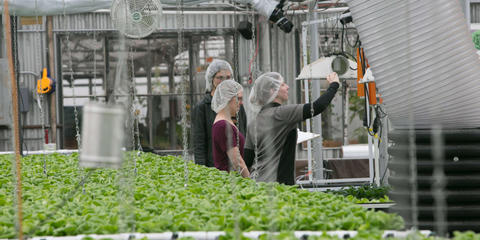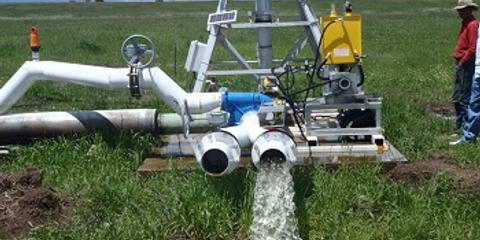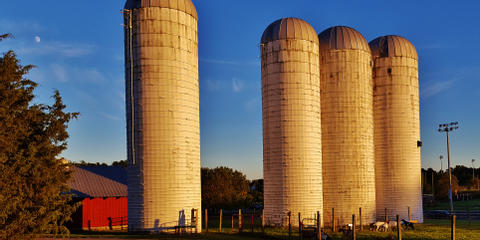Federal funding programs are under review as of 1/27/25. We'll make updates as new info is released.
The Farm Storage Facility Loan Program (FSFL) provides low-interest financing so producers can build or upgrade facilities to store commodities. Eligible commodities include grains, oilseeds, peanuts, pulse crops, hay, honey, renewable biomass commodities, fruits and vegetables, floriculture, hops, maple sap, milk, cheese, yogurt, butter, eggs, meat/poultry (unprocessed), rye and aquaculture. Eligible facility types include grain bins, hay barns, bulk tanks, and facilities for cold storage. Drying and handling and storage equipment is also eligible, including storage and handling trucks. Eligible facilities and equipment may be new or used, permanently affixed or portable.
Since its inception in May 2000, more than 33,000 loans have been issued for on-farm storage, increasing storage capacity by 900 million bushels.
FSFL is an excellent financing program for on-farm storage and handling for small and mid-sized farms, and for new farmers. Loan terms vary from 3 to 12 years. The maximum loan amount for storage facilities is $500,000. The maximum loan amount for storage and handling trucks is $100,000. In 2016 FSA introduced a new loan category, the microloan, for loans with an aggregate balance up to $50,000. Microloans offer a 5 percent down payment requirement, compared to a 15 percent down payment for a regular FSFL, and waive the regular three-year production history requirement.
Enterprises
Eligibility
Eligible Borrower
An eligible borrower is any person who is a landowner, landlord, leaseholder, tenant or sharecropper. Eligible borrowers must be able to show repayment ability and meet other requirements to qualify for a loan.
Eligible Facilities, Equipment and Upgrades
The following types of new/used facilities and upgrades are eligible and must have a useful life for at least the term of the loan:
-
Conventional cribs or bins;
-
Oxygen-limiting structures and remanufactured oxygen-limiting structures;
-
Flat-type storage structures;
-
Electrical equipment and handling equipment, excluding the installation of electrical service to the electrical meter;
-
Safety equipment, such as interior and exterior ladders and lighting;
-
Equipment to improve, maintain or monitor the quality of stored grain;
-
Concrete foundations, aprons, pits and pads, including site preparation, off-farm labor and material, essential to the proper operation of the grain storage and handling equipment;
-
Renovation of existing farm storage facilities, under certain circumstances, if the renovation is for maintaining or replacing items;
-
Grain handling and grain drying equipment determined by the Commodity Credit Corporation to be needed and essential to the proper operation of a grain storage system (with or without a loan for the storage facility);
-
Structures that are bunker-type, horizontal or open silo structures, with at least two concrete walls and a concrete floor;
-
Structures suitable for storing hay built according to acceptable design guidelines;
-
Structures suitable for storing renewable biomass;
-
Bulk tanks for storing milk or maple sap;
-
Cold storage buildings, including prefabricated buildings that are suitable for eligible commodities. Also may include cooling, circulating and monitoring equipment and electrical equipment, including labor and materials for installation of lights, motors and wiring integral to the proper operation of a cold storage facility; and
-
Storage and handling trucks, including refrigerated trucks.
Other examples of equipment include but are not limited to the following:
-
baggers
-
boxers
-
brush polishers
-
bulk bin tippers
-
case palletizers
-
cement flooring
-
circulation fans
-
cold dip tanks
-
conveyors
-
drying tunnels
-
dumpers
-
electrical equipment
-
food safety-related equipment
-
hoppers
-
hydrocoolers
-
hydrolifts
-
ice machines
-
quality graders
-
refrigeration units or systems
-
roller creepfeeders
-
roller spray units
-
safety equipment meeting Occupational Safety and Health Administration requirements
-
sealants
-
sizers
-
sorting bins and/or tables
-
storage and handling trucks
-
washers
-
waxers; and
-
weight graders.
Terms
A producer may borrow up to $500,000 per loan, with a minimum down payment of 15 percent. Loan terms are up to 12 years, depending on the amount of the loan. Producers must demonstrate storage needs based on three years of production history. FSA also provides a microloan option that, while available to all eligible farmers and ranchers, also should be of particular interest to new or small producers where there is a need for financing options for loans up to $50,000 at a lower down payment with reduced documentation.
Applicants for all loans will be charged a nonrefundable $100 application fee.
Microloans:
Producers who select the microloan option can borrow up to $50,000, with the minimum down payment reduced to 5 percent and shorter loan terms. Producers can self-certify the storage needs of the eligible commodity and are not required to demonstrate storage needs based on production history.
Interest Rates:
The May 2022 CCC lending rates are: FSFL Rates
-
2.625 percent per annum for FSFL with 3-year loan terms;
-
2.625 percent per annum for FSFL with 5-year loan terms;
-
2.625 percent per annum for FSFL with 7-year loan terms;
-
2.625 percent per annum for FSFL with 10-year loan terms;
-
2.625 percent per annum for FSFL with 12-year loan terms;
-
2.750 percent per annum for FSFL with 15 year loan terms;
Environmental Evaluation Requirements:
These loans must be approved by the local FSA state or county committee before any site preparation and/or construction can be started.
All loan requests are subject to an environmental evaluation. Accepting delivery of equipment, starting any site preparation or construction before loan approval may impede the successful completion of an environmental evaluation and may adversely affect loan eligibility.
Application Instructions
Loan applications should be filed in the administrative FSA county office that maintains the farm’s records.
Resources
Related Programs

A Multi-Faceted Approach to Incentivizing Woody Perennial Growers to Establish Cover Crops in Orchards in Four Diverse Regions of the United States
Agoro Carbon Alliance US, U.S. Department of Agriculture
- Grant
- Climate-Smart
- CA
- WA
- OR
- MI
- FL
- Fruits
- Tree Nuts

A Vibrant Future
International Fresh Produce Association, U.S. Department of Agriculture
- Grant
- Climate-Smart
- AL
- CA
- FL
- GA
- LA
- Berries
- Grapes
- Fruits
- Vegetables

ACRE3 Agricultural Energy Efficiency
Colorado Department of Agriculture
- Grant
- Cost Share
- Loan
- Alternative Energy
- Conservation
- Irrigation
- Storage
- Greenhouse
- CO
- Any

ACRE3 Irrigation Hydropower Programs
Colorado Department of Agriculture
- Grant
- Cost Share
- Loan
- Hydro Power
- Alternative Energy
- Irrigation
- Conservation
- Water Management
- Equipment
- CO
- Any
Details
Organization
Financial Instrument
Loan
Maximum Award Amount
$500,000
Updated August 30, 2025
Image Credit: matthewbeziat
This information was gathered from public sources. Ambrook is not responsible for or able to affect the results of any financial programs listed, nor are they responsible for any incorrect information that is listed or is on the hyperlinked external sites. All information is subject to change.
Explore hundreds more programs on Ambrook.
